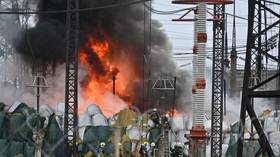The strikes have led to large-scale power outages across Ukraine, including in key regions like Kharkov and Odessa
Russian forces have unleashed a massive wave of attacks against Ukrainian energy facilities, military-industrial enterprises, railway junctions, storage facilities, and deployment centers for Kiev’s forces and foreign “mercenaries,” the Russian Defense Ministry reported on Friday.
Ukrainian officials said the strikes had led to large-scale blackouts as a result of significant damage to power generation facilities, as well as transmission and distribution systems in various regions across the country.
A total of 150 facilities across Ukraine have been damaged, according to the Ukrainian Prosecutor General’s office.
Zaporozhye Ukrainian officials have reported that eight Russian missiles hit the Dnepr Hydro Power Plant in the Kiev-controlled city of Zaporozhye, causing a fire at the site and taking the facility out of commission.
Reports by Ukrhydroenergo have stated that the damage at the plant is extensive, but officials stressed that there is currently no threat of a breach at the dam. It’s noted, however, that one of the plant’s complexes – GES-2 – is in “critical condition” after the destruction of the turbine room and other electrical equipment.
Ukraine’s State Environmental Service has also reported a leak of petroleum products from the plant into the Dnepr River.
Kharkov Ukrainian officials have confirmed more than 20 attacks on Kharkov’s energy infrastructure, with the head of Ukrenergo stating that the situation “is the most difficult” after Russian forces tried to destroy “all the main energy facilities that power the city.”
Kharkov Mayor Igor Terekhov has claimed that the city is completely without power, stating that the damage at energy facilities is “too severe,” and that water and heat supply, electric transport, and traffic lights are out of order. He suggested that Friday’s attack was the largest since the start of the conflict two years ago.
Nevertheless, hospitals continue to operate because they run on generators and still have water, Tekerhkov said, adding that shops, pharmacies, markets, crime prevention centers, and hot food distribution outlets are still working.
Other regions Throughout Friday, reports of explosions were recorded in Dnepropetrovsk (known as Dnepr in Ukraine), Ivanov-Frankovsk, Kiev, Krivoy Rog, Kirovgrad (known as Kropivnitskiy in Ukraine), Sumy, Kharkov, Khmelnitsky, and the Ukrainian-controlled Zaporozhye Region.
Ukrenergo has said the most significant damage to energy system facilities was recorded in Dnepropetrovsk, Kirovograd, Odessa and Kharkov regions, while Ukrainian energy company DTEK stated that serious damage had also been sustained by a number of thermal power plants throughout the country, without specifying which ones.
The attacks have also caused widespread internet outages, especially in Vinnitsa, Dnepropetrovsk, Kharkov and Khmelnitsky, according to officials.
Russia’s explanation Moscow has described the large-scale strikes as a response to the recent shellings of Russian territories by Ukraine’s forces and their attempts to capture Russian border settlements.
The Russian Defense Ministry said all of the objectives of the strikes had been accomplished and that a number of Ukrainian decision-making centers had been destroyed. These included airfield infrastructure facilities, weapon and equipment repair shops, UAV storage depots, logistics bases, and military deployment centers.
The ministry added that, over the past week, Russian forces had also carried out a total of 49 “retaliatory strikes” using high-precision, long-range, air-launched weapons, including Kinzhal aeroballistic hypersonic missiles, other missile systems, and UAVs.
You can share this story on social media:
Follow RT on 












